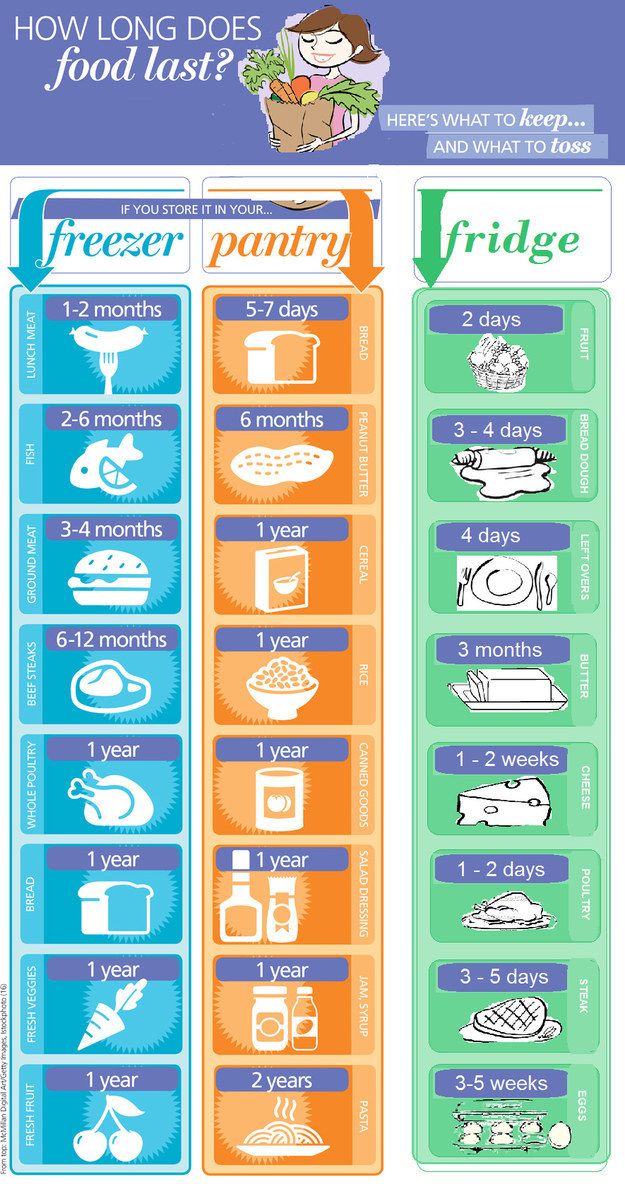Large breast feeding your baby
8 Tips for Breastfeeding with Larger Breasts
For women who have large breasts, breastfeeding may feel like a daunting challenge, but, getting it right is about making sure you and baby can feed with good positioning and attachment...
Share this content
Get a Good Bra Fitted
Firstly, it is important to have good bra support and to go and get correctly measured for a well-fitting and comfortable maternity bra. You may need to do this about 3 times from pregnancy to after birth, as your breasts will be changing shape along your journey. It’s very important that you do not wear an underwire bra or a bra which is too small and cuts into your skin.
Your breasts start making milk (colostrum) in the cells from around 16 weeks pregnant. Having too much pressure on your delicate breast skin from this point may put you at risk of developing blockages and pain. This is particularly important once your milk comes in after birth as this can also restrict the flow of milk to your baby.
The reason why it is best to go and have a proper bra fitting is that most of us women are actually wearing the wrong bra size to start with! This is not a time to be walking around with an incorrect fit.
Understand the Difference Between Breast Size and Milk Output
All breasts come in a variety of shapes and sizes. We are all different and this is normal. A common myth is that a woman with larger breasts makes more milk than a woman with smaller breasts.
Actually, the truth is that the size of your breast does not dictate how much milk you will be able to make. It’s about how much milk the cells inside your breast can make and this is not based on breast size.
The breasts are made up of glandular tissue (containing the milk-making cells), fatty tissue which often represents the size of our breast, and connective tissue.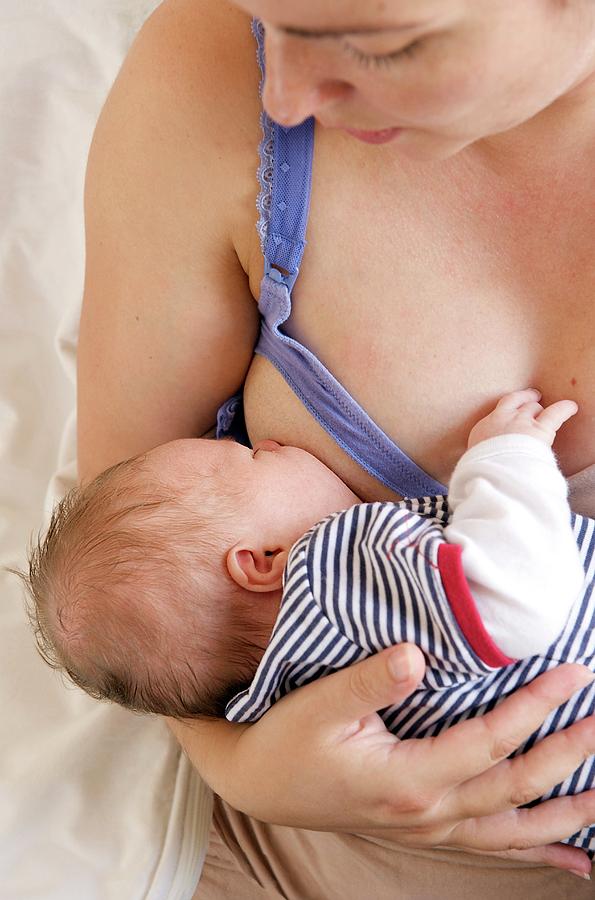 So we cannot assume a woman with G cup breasts will have more milk than the woman with C cup breasts.
So we cannot assume a woman with G cup breasts will have more milk than the woman with C cup breasts.
Learn About Feeding Ergonomics
Often we may only see images of 3 ways of breastfeeding, but this is not true at all. Remember the breast and the baby’s mouth are round, so technically any position is possible… that doesn’t mean it’s comfortable though! And comfort is the key here. The key to successful breastfeeding is getting the positioning and attachment right for mum and baby.
No matter what size breasts they have some mums and babies breastfeed from the beginning with no problems at all, while other mums and babies take a little bit more time to get things right.
Feeding with larger breasts is about being comfortable and being able to see what baby is doing when they attach. Both of these can take a little practice, for any mum.
Give Your Breasts the Support they Need
Many mums find that using a pillow in the early days can help position baby at the right height so they can see baby’s mouth clearly. It’s really important to watch out that you don’t lift your baby up on a pillow above the height of your naturally resting nipple.
It’s really important to watch out that you don’t lift your baby up on a pillow above the height of your naturally resting nipple.
If you do this then you’ll end up lifting your breast to meet your baby’s mouth and will find as soon as you let go of your breast the weight of the breast will pull the nipple out of baby’s mouth! So the key here is to bring baby to the level of your resting nipple.
Other ways of tilting your nipple upwards so you have a better view of your baby’s mouth next to your nipple is to use a rolled-up cloth nappy/thin bunny rug and placing it under your breast. This can really increase your viewing. You may also like to try breastfeeding in front of the mirror so you can see where baby is attaching, until you feel more confident.
Look for Positions that Work for You
Try lots of different positions. There is no one perfect position for every mother, and most mums use a variety of styles depending on whether they are at home, out and about or lying down.
Laid back feeding styles can be really helpful for every breast shape and size as it allows your baby to use their innate reflexes to find the breast and attach themselves. You can find some helpful information here.
Other positions are the modified cradle hold, where baby sits/lies in your lap and is supported behind their shoulders to attach onto the breast. Some mums like the underarm hold as baby is supported beside you and mums often feel like they have support of their baby’s head and neck as well as a perfect view of baby’s mouth, while others love lying down to feed.
These are all positons you can practice with the help of your midwife in hospital and at home.
Consider Shaping the Breast
Lots of mums find it helpful to shape their breast just before baby attaches on to the nipple and underneath part of the areola. Shaping can help baby get a deeper attachment.
It’s important that baby is not just sucking on the end of the nipple. In order to drain the milk effectively and cause no pain baby needs to have the nipple and some of the areola in his mouth.
In order to drain the milk effectively and cause no pain baby needs to have the nipple and some of the areola in his mouth.
Babies do not have to take all of your areola in their mouths! But if you have small areola then he may take it all. There are two ways of holding your breast; it is often called the hamburger technique!
Imagine you are eating a really full, delicious burger (veggie burger for the vegetarians). Think about how you pick it up. You will squeeze it to reduce the size so that you can have a bite of the bun, filling and the burger.
Then you tilt your head back slightly, and bring your bottom lip to the bun first, almost hooking your mouth over the whole burger, so you can fit more in your mouth.
This is what babies do when they come to the breast to feed, tilt their head slightly, and come onto the breast lower lip first with their chin leading.
So shaping the breast can be helpful for some mums and babies to enable baby to get a deeper attachment on the breast.
How do you do it? If you are holding baby in cradle hold then you want to hold your breast in a “U” shape, from underneath your breast. If you are holding baby in an underarm hold you will need to hold your breast in a “C” shape, from the side of your breast.
Wear Clothes That Give You Confidence
Many mums worry that they will be exposing themselves a lot if they have larger breasts. Here are a few tips if you are feeling self-conscious. Practice feeding your baby in the mirror first before you go out.
Try out different tops to find the ones you feel most comfortable feeding in and wear those for your first feeds in public. Try wearing a breastfeeding cami top underneath your t-shirt so you still feel covered whilst feeding.
On your first trip breastfeeding in a café or public place find a secluded chair to feed. Once you find your confidence and breastfeeding style you’ll find breastfeeding out and about to be no problem at all and the easiest method of feeding your baby.
Don’t Be Afraid to Seek Out Advice and Support
Never feel concerned about how much support you need when learning to breastfeed. Nearly every mum finds some aspects of breastfeeding challenging at first and will have good and bad days.
Utilise your local breastfeeding support centres and their lactation consultants and maternal child health nurses until you are feeling confident. There is nothing better than a bit of coaching and TLC from a warm and friendly breastfeeding specialist to help you feel that you can do this!
For more information and updates on breastfeeding join us at our Medela Australia Facebook page.
Do you know someone who has had to learn how to breastfeed with breasts that are on the larger side? What tips did they share with you? Please join the conversation.
Breastfeeding With Large Breasts - Breastfeeding Support
Breastfeeding can run smoothly with all sizes of breast. However, large breasts may make it more challenging to position baby comfortably, or to find nursing bras, pump flanges or nipple shields in larger sizes. This article shares tips for breastfeeding with large breasts and looks at common concerns larger breasted women can have when breastfeeding.
This article shares tips for breastfeeding with large breasts and looks at common concerns larger breasted women can have when breastfeeding.
Search Articles
Need to look something up?
Breastfeeding positions for larger breasts
Our articles Breastfeeding Positions for Newborns and Latching Tips have general information to help a baby attach (latch) comfortably to the breast with a big mouthful of breast tissue as well as a nipple. These should be read alongside the specific breastfeeding tips for the larger breasted mother in this article.
General positioning tips
- Supporting the breast. Finding positions that support a larger breast throughout the feed can help prevent the weight of the breast from pulling out of a baby’s mouth causing him to slide onto the nipple (a shallow latch) or let go of the breast altogether. Supporting the breast also prevents a heavy breast from pressing on baby’s chest.1 Breast support may be achieved in a number of ways (see below), examples include reclining so the breasts are supported by the body, using hands to support the breast, side-lying or using a rolled towel under the breast.
- Pillows and stools. A commercial breastfeeding pillow is unlikely to be needed to lift your baby to breast height in cross cradle or cradle hold if your breasts hang low in your lap, but pillows can be useful to support your arms, back or breast. A chair without arms may be helpful to provide enough space to get comfortable. Bending the knees slightly and resting your feet on a low footstool may also be useful to get comfortable.
Traditional holds with larger breasts
As each mother and baby’s anatomy are slightly different, a breastfeeding position that works for one may not work for another, whatever the size of breast. There are several positions to try but if you are finding positioning difficult, a breastfeeding specialist such as an IBCLC lactation consultant is an ideal partner to help you.
#1 Cradle hold
In cradle hold, baby is held in the crook of one arm and feeds from the breast on the same side. For a larger breasted mother, a modified cradle hold with baby supported on mother’s forearm or wrist area can work well and leaves the opposite hand free to help shape or support the breast if needed. Your baby’s arms can cradle the breast or one arm might reach around your waist. Breast support can be achieved by using the crook of the arm, tummy, pillow, rolled towel or hand under the breast depending on your anatomy. UK lactation consultant Lucy Webber IBCLC shares her technique for breastfeeding with large breasts in cradle hold in the following short clip. In the video Lucy uses the crook of her arm to support the weight of the breast and the flat of her hand on the top of the breast to shape the breast for the latch.
Some mothers may prefer to use a hand to support the breast with thumb lightly resting on top of the breast and fingers supporting it below. Another option depending on size, is a scissor hold or V-hold where the fingers of one hand hold the breast between them. When using hands to support the breast it is important to keep fingers far enough away from the nipple so they don’t disturb baby’s attachment. The hands can also be used to shape the breast to help a baby latch as well as for support (see latching tips and helping baby to latch below).
Another option depending on size, is a scissor hold or V-hold where the fingers of one hand hold the breast between them. When using hands to support the breast it is important to keep fingers far enough away from the nipple so they don’t disturb baby’s attachment. The hands can also be used to shape the breast to help a baby latch as well as for support (see latching tips and helping baby to latch below).
- Advantage: In cradle hold your lap or tummy can often support your breasts so that you can concentrate on keeping baby close with nose level to nipple before he gapes wide to latch on.
- Disadvantage: It may give you less control for helping baby latch.
#2 Laid back positions
In laid back or reclining positions a baby is supported on the mother’s body in full body contact and the breasts are also supported by the mother’s body. Baby could be lying at almost any angle that works, including sitting astride his mother’s thigh (called a laid back straddle hold).
Baby could be lying at almost any angle that works, including sitting astride his mother’s thigh (called a laid back straddle hold).
Advantages
- Laid back positions and some skin-to-skin contact help a baby use his feeding reflexes for self-latching.
- Reclining into your chair opens up the space in your lap for your baby.
- Leaning backwards can allow breast tissue to flatten slightly so that it falls away from a baby’s nose instead of surrounding it.
- The weight of the breast is not on baby’s chest.
Disadvantages
- Leaning back too far may mean that your breasts flop to the sides of your body into your armpits which can make latching more difficult.
- Laid back positions may feel more awkward for a larger breasted woman as she may not be able to see how her baby is latching behind the curve of her breasts.
In the following video, lactation consultant Nancy Mohrbacher chats to a mother as she breastfeeds in a laid back or reclining position. The mother’s body supports her breasts. Some mothers may find they still prefer to support their breasts with a hand in this position, or that the position doesn’t suit them.
The mother’s body supports her breasts. Some mothers may find they still prefer to support their breasts with a hand in this position, or that the position doesn’t suit them.
#3 Rugby hold
In rugby (clutch or football) hold, baby is supported under mother’s arm at breast height. Depending on her natural breast height a mother may or may not need to lift her baby on a pillow so that baby’s nose is level with the nipple prior to latching. A rolled cloth or towel can be placed under the breast if needed for support.
- Advantage: This position leaves a hand free to help shape the breast for an assisted latch (see below), for breast compressions or to support the breast throughout the feed if needed.
- Disadvantage: A heavy breast should not rest on your baby’s chest—but this could be an issue in rugby hold. Adjust your baby’s position as needed or support the breast throughout the feed.
#4 Side-lying
Breastfeeding lying on your side so that the mattress (or floor) supports the breast can be a comfortable position. In the image below, moving baby a little further down the bed and bringing their body closer to mum will help to bring contact between the chin and the breast so that the nose is clear of breast tissue.
In the image below, moving baby a little further down the bed and bringing their body closer to mum will help to bring contact between the chin and the breast so that the nose is clear of breast tissue.
Advantages
- The weight of the breast is supported by the mattress.
- Some larger breasted women can breastfeed from both the upper and lower breast from a side-lying position without switching sides.
Disadvantage
- It can take a little practice to latch a baby lying down with any sized breast. Latching baby in a semi laid back position and then sliding down with baby and breast in the same position can work for some mothers.
#5 Using a table or flat surface
Some mothers have found sitting at a table to breastfeed, where the table supports both baby and the weight of the breast, recreates a side-lying position without lying down. Using a suitable breastfeeding pillow can create a similar more flexible position.
Using a suitable breastfeeding pillow can create a similar more flexible position.
- Advantage: The weight of the breast is supported by the table or pillow.
- Disadvantage: The supporting surface needs to be at the right height with good back support for mum.
#6 Cross cradle
Cross cradle involves holding your baby using the opposite arm to the side of the breast that is being fed from—with your hand across baby’s shoulders. Your other hand is free to shape and support the breast for the latch.
- Advantage: Cross cradle can give often give good control for an “assisted latch” (see below).
- Disadvantage: Cross cradle can pose a challenge for a larger breasted mother if her arms cannot reach around baby and breast.
Tips for good attachment
The “latch” describes how a baby attaches to the breast once they are in one of the comfortable breastfeeding positions above.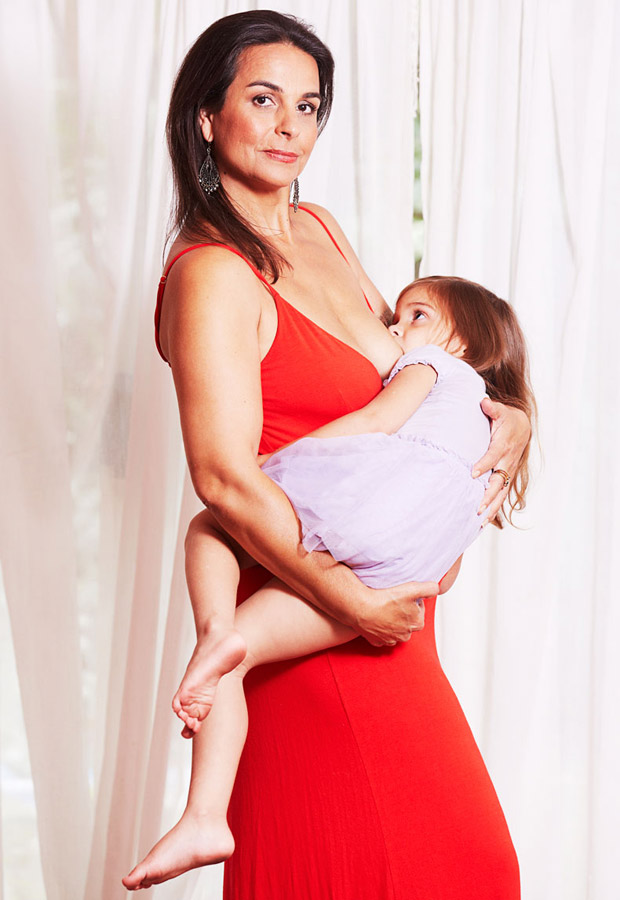 As with any sized breast, a baby needs to have a big deep mouthful of breast tissue as well as the nipple. This ensures breastfeeding is comfortable for you and that your baby can get plenty of breast milk. Our related article Latching Tips describes how to get a comfortable latch.
As with any sized breast, a baby needs to have a big deep mouthful of breast tissue as well as the nipple. This ensures breastfeeding is comfortable for you and that your baby can get plenty of breast milk. Our related article Latching Tips describes how to get a comfortable latch.
Nose to nipple
General advice to position your baby nose to nipple before he gapes to latch, may be difficult for the larger breasted woman if she cannot see her nipple without lifting or adjusting her breast. However moving a breast to the left or right from its natural resting place to reach the baby will mean it tends to pull out of your baby’s mouth during a feed when it tries to return to its usual position. If it is difficult to bring baby to the nipple due to their position, supporting the breast through the feed can help with this natural movement.
Helping baby to latch
Babies are often able to latch on all by themselves using their feeding reflexes once they are held in a comfortable breastfeeding hold, especially in reclining positions. If more help is needed see the ideas below and see Latching Tips for more guidance:
If more help is needed see the ideas below and see Latching Tips for more guidance:
- Shaping or flattening the breast with your thumb and fingers placed around the breast behind the nipple can help baby get a deeper latch. This is sometimes called an “assisted latch”. Depending on where you put your fingers on the breast and the shape made between the fingers and thumb you may also hear it called a C-hold /U-hold or a scissor-hold/v-hold. The goal is to flatten the breast in the same way that you might flatten a big salad filled sandwich or burger in a bun to fit your mouth before you take a bite. Exactly where your fingers press on the breast to flatten it, so the “sandwich” is smaller and not fatter, will depend on the position you hold your baby in and which direction their mouth is coming from.
- An asymmetric latch. When a baby is breastfeeding well they have more of the breast tissue below the nipple in their mouth than the breast above it and this is called an asymmetric latch (off centre).
 If needed a baby can be helped to latch asymmetrically by shaping the breast with finger pressure behind the nipple to make the nipple point upwards as baby latches. You may hear this called the “flipple”, “exaggerated latch” or “nipple flick”.
If needed a baby can be helped to latch asymmetrically by shaping the breast with finger pressure behind the nipple to make the nipple point upwards as baby latches. You may hear this called the “flipple”, “exaggerated latch” or “nipple flick”. - Keep fingers clear. Remember to keep your fingers sufficiently far from the latch so your baby can get a big mouthful of breast.
- A rolled cloth or towel placed under the breast can help adjust breast height or alter the shape of the breast to help latching. Sometimes the cup of a nursing bra can be tucked under the breast to provide support or some mothers have made a breast support from a loop of stretchy material (eg the leg from an old pair of tights). Worn around the neck like a necklace your breast can be slipped into the “sling” created.
Large nipples
Nipples come in many shapes and sizes, they increase in size during pregnancy and during breastfeeding a nipple can extend to twice its length. An average nipple diameter might be 16mm-17.5mm2 and many will fall in a range between 16 and 23mm diameter3.
An average nipple diameter might be 16mm-17.5mm2 and many will fall in a range between 16 and 23mm diameter3.
Particularly large diameter nipples may fill a baby’s mouth without leaving room for any breast. If a baby is only latched to the tip of the nipple it will make it difficult for your baby to keep milk flowing and will likely cause painful, sore nipples. Whether there will be any problems for your baby if your nipples are much larger or longer than average will depend on the size of your baby’s mouth, and how stretchy or how long the nipple is. A breastfeeding specialist may be able to offer suggestions to help your baby latch more comfortably. In time, baby will grow and his mouth will better fit the nipple.
Flat nipples
As a baby breastfeeds rather than nipple feeds they are capable of breastfeeding with lots of different shapes and sizes of nipple. However some babies find flat nipples more challenging. For help with this see Breastfeeding With Inverted Nipples and Flat Nipples. Nipple shields (silicone covers with holes to protect the nipple) are sometimes used by mothers with flat nipples however they tend to come in sizes that cater for average nipples. See Nipple Shields Good or Bad? for information about sizes and brands of nipple shield and how to use them if needed.
However some babies find flat nipples more challenging. For help with this see Breastfeeding With Inverted Nipples and Flat Nipples. Nipple shields (silicone covers with holes to protect the nipple) are sometimes used by mothers with flat nipples however they tend to come in sizes that cater for average nipples. See Nipple Shields Good or Bad? for information about sizes and brands of nipple shield and how to use them if needed.
Disappearing nipples
If breasts get engorged, nipples can quickly flatten out and literally seem to disappear making it more difficult for your baby to latch. This disappearance is temporary. Shaping the breast, expressing a little milk to bring out the nipple, or reverse pressure softening can help: see Engorged Breasts for further information.
Pumping to protect milk supply
Until baby’s mouth has grown (a week or two can make a big difference), or if you are experiencing any difficulties breastfeeding, it can be helpful to express your breast milk to keep your milk supply stimulated and your baby well fed until they can breastfeed more comfortably. Milk can be expressed by hand or pump. Choose a pump that has a large enough flange (the part of the pump that is held against the breast) and nipple tunnel (the opening over the nipple). If the nipple tunnel is too small the nipple may rub along its sides causing cracking at the base of the nipple, abrasions (grazing) on the nipple tip (Wilson-Clay and Hoover, 2017) or it may compress milk ducts and slow milk flow 4. The following article has much more information on choosing a breast pump and the different sizes of flange available: How to Increase Milk Supply When Pumping.
Milk can be expressed by hand or pump. Choose a pump that has a large enough flange (the part of the pump that is held against the breast) and nipple tunnel (the opening over the nipple). If the nipple tunnel is too small the nipple may rub along its sides causing cracking at the base of the nipple, abrasions (grazing) on the nipple tip (Wilson-Clay and Hoover, 2017) or it may compress milk ducts and slow milk flow 4. The following article has much more information on choosing a breast pump and the different sizes of flange available: How to Increase Milk Supply When Pumping.
Common concerns
#1 Are my breasts a suffocation risk?
Some mothers may feel concerned that their breasts could be a suffocation risk for their baby, either from the weight of the breast on their baby or a concern that baby can’t breathe easily when buried in a very large soft breast. Always check your positioning very carefully while breastfeeding and note the following tips:
Always check your positioning very carefully while breastfeeding and note the following tips:
- Leaning back slightly can allow the breast tissue to fall away from a baby’s nose and with baby in a prone position (on their tummy) the weight of the breast will be under baby not on top of them.
- Holding or supporting the breast will take the weight off a baby in cradle, cross cradle or rugby hold and will also allow some breast shaping to ensure your baby’s nose is free needed.
- Where breasts are very soft and large, a baby’s nose can be kept clear of breast tissue by pressing a thumb or finger into the breast adjacent to their nose.
- Bringing baby’s chin closer to the breast by adjusting their body position slightly may help to increase the space between breast tissue and baby’s nose.
 adobe.com
adobe.com#2 Will large breasts mean too much milk?
It is not possible to predict the amount of milk making tissue in the breast by size alone since breast size is mostly determined by the amount of fat present in the breast. Large breasts are therefore not necessarily a sign of more milk compared to smaller breasts5 and large breasts do not necessarily have a larger storage capacity (the amount of milk a breast can hold).
Plenty of milk
Some mothers with large breasts will have plenty of glandular tissue and lots and lots of milk. They may feel quite swamped with milk, finding it leaks and spurts like a tap. They may find they keep getting engorged and avoiding blocked ducts and preventing mastitis can seem like a losing battle if a baby can’t keep up with the flow.
- To help your supply regulate to your baby’s needs, have a look at Oversupply of Breast Milk.

- Expressing enough milk to stay comfortable and ensuring your baby finishes the first breast before offering the second is usually helpful.
- Regular gentle massage of any areas of the breast that are not getting fully drained may help avoid engorgement. With moderately large or pendulous breasts the lactation tissue may be further back in the breast and harder to relieve by hand expression, massage or pump.
Obesity and milk supply
Overweight or obese women with larger breasts and a body mass index (BMI) greater than 26 may be at risk of delayed onset of lactation or a low milk supply.6 7 They may have other challenges associated with obesity such as increased risk of caesarean and postpartum oedema which can affect breastfeeding too. 8 For further information about obesity and milk supply see No Breast Milk After Delivery. To ensure breastfeeding gets off to a good start, hand expressing within the first hour of birth can help with milk supply and contact an IBCLC lactation consultant or breastfeeding specialist.
8 For further information about obesity and milk supply see No Breast Milk After Delivery. To ensure breastfeeding gets off to a good start, hand expressing within the first hour of birth can help with milk supply and contact an IBCLC lactation consultant or breastfeeding specialist.
Not enough milk
There are lots of ways to increase a milk supply see Reasons for Low Milk Supply and How to Make More Breast Milk.
Implants
For information about milk supply for mothers who have had breast implants see Breastfeeding With Implants.
#3 How can I breastfeed in public?
Larger breasted ladies may feel they have to expose more of their body than they are comfortable with when breastfeeding—making breastfeeding in public daunting for them. Wearing under layers, large stretchy vests that can be pulled down to keep a tummy covered or a man’s vest with arm holes large enough to bring a breast through may be helpful. If the rugby hold works well for you, some mothers use their baby changing bag or a rolled up coat to rest the baby on instead of taking a pillow everywhere they go.
If the rugby hold works well for you, some mothers use their baby changing bag or a rolled up coat to rest the baby on instead of taking a pillow everywhere they go.
#4 Where can I find a good nursing bra?
It can be a challenge to find a good fitting maternity bra in larger sizes. It is important that bras fit properly during lactation so that any seams or edges are not cutting into breast tissue and are well back in the arm pit behind the glandular tissue. Anything cutting into the breast including underwired bras could be a risk factor for mastitis or blocked ducts.
- Some mothers have converted their favourite non-maternity bra into a nursing bra (you can search online for ways to do this).
- Shopping online may offer more choice than department stores. Larger sizes are stocked by bras4mums (UK), bravissimo.com and amplebosom.com.
- See Nursing Bras FAQ for further general information about nursing bras.
Night bras
A large breasted mother may feel more comfortable at night if she wears a bra. Be wary of wearing a bra at night that is too tight or cuts into the breast tissue as this could cause blocked ducts or mastitis. Look for a lightweight stretchy cotton sleep bra that holds breast pads in place if needed and provides gentle support.
Be wary of wearing a bra at night that is too tight or cuts into the breast tissue as this could cause blocked ducts or mastitis. Look for a lightweight stretchy cotton sleep bra that holds breast pads in place if needed and provides gentle support.
#4 Why am I getting rashes and itches?
Mothers with larger breasts may find they get very hot and have heat rashes or outbreaks of thrush in the folds beneath their breasts. And some mothers find stretch marks on their breasts can itch. Cotton bras and fabrics next to the breast can help with air circulation along with keeping the area cool, clean and dry.
#5 How much bigger will breasts get during lactation?
Some mothers find their breasts increase about two cup sizes during pregnancy ready for breastfeeding. Others may note a size increase of five cup sizes or more giving rise to unexpectedly large, or larger, breasts. In most cases after lactation, breasts will return to their original size, some may be a little smaller or larger.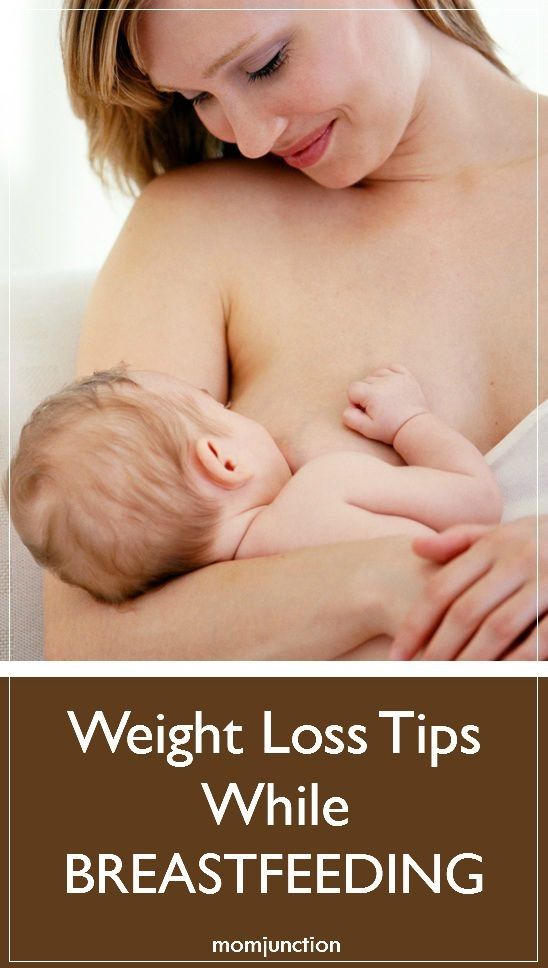
Gestational gigantomastia
Rarely, a mother experiences something called gestational gigantomastia—extreme breast tissue overgrowth during pregnancy. This can make breastfeeding difficult or even impossible because of the size and weight of the breasts. Breasts can spontaneously return to normal size after the birth but in some cases surgical intervention by breast reduction may be needed.9
Considering breast reduction
For women considering breast reduction, breastfeeding after breast reduction surgery is possible. However, whether or not a mother can make a full supply of breast milk after surgery will depend on the type of surgery involved and how much functional tissue was removed. For more information about breast reduction surgery see Breast Reduction and Breastfeeding.
Summary
Breastfeeding with large breasts may present a few extra challenges for mother and baby. However, with good breastfeeding help to find the right position, or a little time for a baby’s mouth to grow to fit the breast, mother and baby can soon master breastfeeding.
However, with good breastfeeding help to find the right position, or a little time for a baby’s mouth to grow to fit the breast, mother and baby can soon master breastfeeding.
Footnotes & References
-
Wambach and Spencer. Breastfeeding and Human Lactation (6th ed) 2021 p 191
-
Wambach and Spencer. Breastfeeding and Human Lactation. 2021. p53
-
Wilson Clay and Hoover. The Breastfeeding Atlas. 6e. 2017 p 78/9
-
Marasco & West. Making More Milk. 2020 p 196
-
Anatomy of the lactating human breast redefined with ultrasound imaging, Ramsay, et al, 2005
-
Prepregnant overweight and obesity diminish the prolactin response to suckling in the first week postpartum, Rasmussen and Kjolhede, 2004
-
Risk factors for suboptimal infant breastfeeding behavior, delayed onset of lactation, and excess neonatal weight loss, Dewey et al, 2003
-
Delayed onset of lactogenesis among first-time mothers is related to maternal obesity and factors associated with ineffective breastfeeding, Mommsen-Rivers et al, 2010
-
Gestational gigantomastia with complete resolution in a Nigerian woman, Ezem et al, 2011
Various breastfeeding positions
Try different breastfeeding positions to find the one that works best for you and your baby. You can see the options in our selection of photos
You can see the options in our selection of photos
Share this information
There is no right or wrong way to hold the baby while
feeding, and mom and baby are sure to find their favorite position.
It is important that both you and your child feel comfortable. 1.2 It's good to learn a few different breastfeeding positions and techniques because life's circumstances often require us to be flexible, especially as your baby gets older and you start to leave the house more often.
Whatever position you choose to breastfeed your baby, remember a few simple rules.
- Prepare everything you need before feeding, including drinks, food, mobile phone, TV remote control, book or magazine. And do not forget to go to the toilet - the feeding process can take a long time!
- Make sure your baby is comfortable. Whichever position you choose, it's important to keep your baby strong, level, and provide good support for their head, neck, and spine.

- You should also be comfortable. Don't stress. If necessary, use pillows of different sizes or rolls of towels to support your back or arms.
- Make sure your baby is latching on correctly. Proper grip is the key to comfort when breastfeeding.
- If your baby does not latch on well or you experience pain while feeding, contact a lactation consultant for help. The specialist will also be able to show you how to hold your baby more comfortably.
1. Relaxed feeding or reclining position
The relaxed feeding position, also known as biological feeding, 1 is often the first position for most mothers. If, immediately after birth, the baby is placed on the mother’s chest or stomach, normally, he instinctively reaches for the breast and tries to grab the nipple. This phenomenon is known as the breast seeking reflex. Skin-to-skin contact stimulates the infant's feeding instinct, and gravity helps him to latch onto the breast and maintain balance.
But it's not just newborns that can be fed in the reclining position - this position is great for babies of all ages. It can be especially helpful if your baby does not latch well in other positions or does not like to be touched during feeding, and also if you have too much milk flow or too large breasts. Isabelle, a mother from the UK, shares her experience: “I had large breasts, and the baby was born small - 2.7 kg, so it was not easy to find a comfortable position at first. After a few weeks, it became clear that there was no “correct” posture for me. As a result, I most often fed lying down, putting the baby on my chest. ”
It is more convenient to feed not lying flat on your back, but half-sitting, leaning on pillows. So you will have a back support and you will be able to watch the baby during feeding.
2. Cradle position
This is the classic
first thought of breastfeeding. Mom sits straight
, and the baby lies on her side on her arm, pressing his stomach against her stomach. 3 Although this is a very popular position, it is not always easy to master with newborns because it gives the baby less support. Try putting a pillow under your back, and put a special breastfeeding pillow on your knees and lean on it with your hands. So you can more reliably support the child, without overstraining your back and shoulders. Just make sure that the baby does not lie too high on the pillow for feeding. The breast should remain at a natural level so that the baby can grab it without effort, otherwise sore nipples cannot be avoided.
3 Although this is a very popular position, it is not always easy to master with newborns because it gives the baby less support. Try putting a pillow under your back, and put a special breastfeeding pillow on your knees and lean on it with your hands. So you can more reliably support the child, without overstraining your back and shoulders. Just make sure that the baby does not lie too high on the pillow for feeding. The breast should remain at a natural level so that the baby can grab it without effort, otherwise sore nipples cannot be avoided.
“I breastfed in the cradle position because it suited me perfectly! It was comfortable and I loved just sitting and looking at my little one,” recalls Rachel, a mother of two from Italy.
3. Cross Cradle
This breastfeeding position looks almost the same as Cradle, but the baby is on the other arm. 3 This gives your baby support around the neck and shoulders so he can tilt his head to latch on. This position is great for breastfeeding newborns and small babies, as well as for babies who do not latch well. Since the baby lies completely on the other hand, it becomes easier to control his position and you can adjust the chest with your free hand.
This position is great for breastfeeding newborns and small babies, as well as for babies who do not latch well. Since the baby lies completely on the other hand, it becomes easier to control his position and you can adjust the chest with your free hand.
Julie, a UK mother of two, finds this position very practical: “I usually breastfeed my youngest in the cross cradle position. So I have a free second hand, and I can take care of an older baby at the same time. ”
Do not hold the baby's head at first, otherwise you may inadvertently press his chin against his chest. Because of this, the child will not be able to take the breast deeply, because the nipple will rest against the base of the tongue, and not against the palate, which will lead to inflammation of the nipples. As the child grows, this position becomes more comfortable, and he can rest his head on your palm (as shown in the photo above).
4. Underarm breastfeeding
In this position, also known as the “ball grip”, the mother sits with the baby lying along her arm at the side, legs towards the back of the chair (or any other seat). 3 Another comfortable position for newborn breastfeeding, you can give your baby good support, full control of his position and a good view of his face. And the baby feels safe in close contact with the mother's body. This position is especially good for those who have had a caesarean section or a premature birth, as well as mothers of twins and women with large breasts.
3 Another comfortable position for newborn breastfeeding, you can give your baby good support, full control of his position and a good view of his face. And the baby feels safe in close contact with the mother's body. This position is especially good for those who have had a caesarean section or a premature birth, as well as mothers of twins and women with large breasts.
“When I breastfed my first daughter, I had very large K-sized breasts—twice the size of her head,” recalls Amy, an Australian mother of two. - I put rolls of towels under each breast, because they were very heavy, and fed my daughter in a pose from under the arm, but only sitting straighter so as not to crush her. This position was also convenient because I had a caesarean section and could not put the baby on my stomach.”
5. Side-lying position
The side-lying position is ideal for a relaxed
nighttime feeding in bed or on the couch. If you had a
caesarean section or ruptures during childbirth, this position may be more comfortable than sitting down. 3 In this position, mother and baby lie side by side, tummy to tummy.
3 In this position, mother and baby lie side by side, tummy to tummy.
“It was difficult for me to sit during endless night feedings, firstly because of the caesarean section, and secondly because of lack of sleep,” recalls Francesca, a mother from the UK. “And then I discovered that you can feed your baby lying on your side and rest at the same time.”
“Because of the short tongue frenulum, Maisie could only properly latch on to her breasts while lying on her side. The lactation consultant showed me how it's done. In this position, the flow of milk was optimal for my daughter, and it was easier for her to keep the nipple in her mouth. As she got older, she became much better at grabbing her breasts in normal positions,” says Sarah, mother of two from Australia.
6. Relaxed breastfeeding after caesarean section
If you can't find a comfortable position for breastfeeding after caesarean section, 3 try holding the baby on your shoulder in a reclining position – this does not stress the postoperative suture and allows you to breastfeed your baby comfortably. You can also try side feeding.
You can also try side feeding.
7. Sitting upright breastfeeding or “koala pose”
When breastfeeding in an upright position or “koala pose”, the baby sits with a straight back and a raised head on the mother's hip. 4 This position can be tried even with a newborn if it is well supported, but it is especially convenient for feeding a grown child who can already sit up by himself. The upright sitting position, or “koala pose,” is great for toddlers who suffer from reflux or ear infections and feel better sitting. In addition, this pose may be suitable for children with a shortened frenulum of the tongue or reduced muscle tone.
“When my daughter got a little older, I would often feed her in an upright position, which was more comfortable for both of us, and I could still hold her close,” recalls Peggy, a mother from Switzerland. “Besides, it was possible to discreetly breastfeed her in public places.”
8. Overhanging position
In this position, the baby lies on his back, and the mother bends over him
on all fours so that the nipple falls directly into his mouth. 4 Some moms say this breastfeeding position is good to use occasionally for mastitis, when touching the breasts is especially unpleasant. Some say that this breastfeeding position helps with blockage of the milk ducts, although there is no scientific evidence for this yet. You can also feed in the “overhanging” position while sitting, kneeling over the baby on a bed or sofa, as well as reclining on your stomach with support on your elbows. Pillows of various sizes that you can lean on will help you avoid back and shoulder strain.
4 Some moms say this breastfeeding position is good to use occasionally for mastitis, when touching the breasts is especially unpleasant. Some say that this breastfeeding position helps with blockage of the milk ducts, although there is no scientific evidence for this yet. You can also feed in the “overhanging” position while sitting, kneeling over the baby on a bed or sofa, as well as reclining on your stomach with support on your elbows. Pillows of various sizes that you can lean on will help you avoid back and shoulder strain.
“I have breastfed several times in the 'overhang' position for clogged milk ducts when no other means of dissolving the blockage worked. And this pose seems to have helped. I think it's because of gravity, and also because the breasts were at a completely different angle than with normal feeding, and my daughter sucked her differently, ”says Ellie, a mother of two from the UK.
Feeding in the "overhanging" position is unlikely to be practiced regularly, but in some cases this position may be useful.
“I used to breastfeed in the overhang position when my baby was having trouble latch-on,” says Lorna, mother of two in the UK. - This, of course, is not the most convenient way, but then I was ready for anything, if only he could capture the chest. We succeeded and have been breastfeeding for eight months now!”
9. Breastfeeding in a sling or in a sling
Breastfeeding in a sling takes some practice, but it can be used to go out, look after older children, or even do a little household chores.
The sling is also useful if the baby does not like to lie down or is often attached to the breast. Lindsey, a mother of two in the US, notes: “I used the carrier frequently for both of my children. When we were out, I tied the sarong around my neck and covered the carrier with it. Under such a cape, the baby can eat as much as he wants until he falls asleep.
This breastfeeding position is best when the baby is already good at breastfeeding and can hold his head up by himself. Any slings are suitable for breastfeeding, including elastic and rings, as well as carrying bags. Whatever option you choose, the main thing is that you can always see the face of the child, and his chin does not rest against his chest.
Any slings are suitable for breastfeeding, including elastic and rings, as well as carrying bags. Whatever option you choose, the main thing is that you can always see the face of the child, and his chin does not rest against his chest.
10. Double hand-held breastfeeding
Double hand-held breastfeeding (or “double-ball grab”) is great for mothers of twins—you can breastfeed both at the same time and keep your arms relatively free. 4 When feeding in this position, it is advisable to use a special pillow for breastfeeding twins, especially at first. It will provide extra support and help keep both babies in the correct position, as well as reduce the burden on the abdomen if you had a caesarean section. In addition, the hands are freer, and if necessary, you can deal with one child without interfering with the second.
“My twins were born very tiny and had to be fed every two hours at any time of the day or night. Very soon it became clear: if I want to do anything besides feeding, I need to feed them both at the same time, - says Emma, mother of two children from the UK. “I breastfed them two by hand using a breastfeeding pillow.”
“I breastfed them two by hand using a breastfeeding pillow.”
Other good positions for breastfeeding twins are two criss-cross cradles, one baby in the cradle and the other close at hand, reclining feeding, or sitting upright (one baby on one side, the other on the other).
11. Breastfeeding in the "hand-supported" or "dancer's hand" position
muscle tone (which is typical for premature babies, children suffering from various diseases or Down syndrome), try supporting his head and your chest at the same time. 4 Grasp your chest with your palm underneath so that your thumb is on one side and all the others are on the other. Move your hand slightly forward so that your thumb and forefinger form a "U" just in front of your chest. With the other three fingers, continue to support the chest. With your thumb and forefinger, hold the baby's head while feeding so that his chin rests on the part of the palm between them, your thumb gently holds the baby on one cheek, and your index finger on the other. So the baby gets excellent support, and you can control his position and see if he is holding his breast.
So the baby gets excellent support, and you can control his position and see if he is holding his breast.
Literature
1 Colson SD et al. Optimal positions for the release of primitive neonatal reflexes stimulating breastfeeding. Early Hum Dev . 2008;84(7):441-449. - Colson S.D. et al., "Optimal Positions for Provoking Primitive Innate Reflexes to Induce Breastfeeding." Early Hume Dev. 2008;84(7):441-449.
2 UNICEF UK BFHI [ Internet ]. Off to the best start ; 2015 [ cited 2018 Feb ]. - UNICEF UK, Baby-Friendly Hospital Initiative, Start the Best You Can [Internet]. 2015 [cited February 2018].
3 Cadwell K. Latching - On and Suckling of the Healthy Term Neonate: Breastfeeding Assessment. J Midwifery & Women's Health. 2007;52(6):638-642. — Cadwell, K., "Latching and sucking in healthy newborns: evaluation of breastfeeding." F Midwifery Women Health. 2007;52(6):638-642.
J Midwifery & Women's Health. 2007;52(6):638-642. — Cadwell, K., "Latching and sucking in healthy newborns: evaluation of breastfeeding." F Midwifery Women Health. 2007;52(6):638-642.
4 Wambach K, Riordan J, editors. Breastfeeding and human lactation. Jones & Bartlett Learning ; 2014. 966 p . - Wambach K., Riordan J., "Breastfeeding and female lactation". Burlington, MA: Publishing House Jones & Bartlett Learning ; 2014. Pp. 966.
Prejudices related to breastfeeding
Instead of an introduction, I would like to say that the ideas of modern women about breastfeeding are a collection of prejudices. They are so common that in many books for expectant mothers and in magazines for parents, it is actions based on prejudice that are described as correct and necessary.
“Breastfeeding is something incredibly difficult, almost no one is able to feed for a long time, everyone always has a lot of problems and one continuous inconvenience”
There is nothing easier, more convenient, more pleasant for mother and child, and, by the way, cheaper, than proper breastfeeding. But for that to be the case, breastfeeding needs to be learned. The best teacher in this matter may not be a book or a magazine for parents, but a woman who has been breastfeeding her child for a long time, more than a year, and receiving positive emotions from this. There are women who breastfeed for a long time and perceived it as a punishment. For example, one mother fed a child for 1.5 years and for all these 1.5 years she pumped after each feeding, and when she decided that she was enough and decided to wean the child, she had mastitis due to wrong actions. Now she tells everyone that breastfeeding is hell. She didn't feed her baby properly for a single day.
But for that to be the case, breastfeeding needs to be learned. The best teacher in this matter may not be a book or a magazine for parents, but a woman who has been breastfeeding her child for a long time, more than a year, and receiving positive emotions from this. There are women who breastfeed for a long time and perceived it as a punishment. For example, one mother fed a child for 1.5 years and for all these 1.5 years she pumped after each feeding, and when she decided that she was enough and decided to wean the child, she had mastitis due to wrong actions. Now she tells everyone that breastfeeding is hell. She didn't feed her baby properly for a single day.
"Breastfeeding spoils the shape of the breast"
It is true that breastfeeding does not improve the shape of the breast, but the breast changes during pregnancy. It is then that it increases and becomes heavier, and, if its shape contributes to this, it “sags”.
Breast changes during lactation. Approximately 1-1. 5 months after birth, with stable lactation, it becomes soft, produces milk almost only when the baby suckles. After the end of breastfeeding, 1.5-3 or more years after the birth of the baby, involution of the mammary gland occurs, lactation stops. Iron "falls asleep" until the next time. Under natural conditions, the end of breastfeeding always coincides with a decrease in the baby's need for breastfeeding. The chest remains soft, inelastic. The shape of the breast largely depends on the presence of adipose tissue in it, the amount of which decreases during prolonged breastfeeding. After the end of breastfeeding, adipose tissue is gradually restored. If a woman does not feed a child, the involution of the mammary gland occurs within the first month after childbirth. The shape of the breast still does not return to its pre-pregnancy state. And if you think about it and figure out why a woman has breasts at all? It's for breastfeeding.
5 months after birth, with stable lactation, it becomes soft, produces milk almost only when the baby suckles. After the end of breastfeeding, 1.5-3 or more years after the birth of the baby, involution of the mammary gland occurs, lactation stops. Iron "falls asleep" until the next time. Under natural conditions, the end of breastfeeding always coincides with a decrease in the baby's need for breastfeeding. The chest remains soft, inelastic. The shape of the breast largely depends on the presence of adipose tissue in it, the amount of which decreases during prolonged breastfeeding. After the end of breastfeeding, adipose tissue is gradually restored. If a woman does not feed a child, the involution of the mammary gland occurs within the first month after childbirth. The shape of the breast still does not return to its pre-pregnancy state. And if you think about it and figure out why a woman has breasts at all? It's for breastfeeding.
"Breastfeeding spoils the figure"
Many women are afraid to gain weight while breastfeeding. But usually a woman gains weight mainly during pregnancy, and not when she is nursing. Moreover, if before pregnancy she tried to meet certain fashionable standards, for example, 90-60-90, during pregnancy she returns to her weight, her genetically incorporated physiological norm (and it may be far from fashionable standards) + the well-known 7-10kg per uterus, fetus, amniotic fluid, increased volume of circulating blood and a little bit more for various little things. Weight gain during pregnancy can be significant. Many women begin to lose weight after 6-8 months of feeding, and gradually, in the second, third year of feeding, she “drops” everything that she has accumulated. It turns out that the figure from breastfeeding often just improves.
But usually a woman gains weight mainly during pregnancy, and not when she is nursing. Moreover, if before pregnancy she tried to meet certain fashionable standards, for example, 90-60-90, during pregnancy she returns to her weight, her genetically incorporated physiological norm (and it may be far from fashionable standards) + the well-known 7-10kg per uterus, fetus, amniotic fluid, increased volume of circulating blood and a little bit more for various little things. Weight gain during pregnancy can be significant. Many women begin to lose weight after 6-8 months of feeding, and gradually, in the second, third year of feeding, she “drops” everything that she has accumulated. It turns out that the figure from breastfeeding often just improves.
Very often it turns out that a woman, having stopped breastfeeding 1.5-2 months after giving birth, begins to gain weight. Perhaps this is due to the resulting hormonal imbalance, tk. no woman is designed for such a rapid cessation of lactation.
"You have to prepare the breast for feeding." And then various recommendations follow, from sewing hard rags into the bra to advice to the husband at the end of pregnancy to “dissolve the ducts” of his wife
There is no need to prepare the breast for feeding, it is so arranged by nature that by the time of birth it is quite ready to feed the child. Cloths, for example, can cause skin irritation. Any manipulation of the nipple at the end of pregnancy can lead to very undesirable consequences due to the stimulation of the oxytocin reflex: stimulation of the nipple - release of oxytocin - contraction of the muscles of the uterus under the influence of oxytocin - the uterus is "in good shape" - and, as the worst option, stimulation of premature labor. And in general, has anyone seen a cat with a rag in a bra, or a monkey doing a hardening shower massage?
“With a flat, let alone inverted nipple, breastfeeding is impossible”
Strange as it may seem to people who have never breastfed, a baby's nipple is just a point from which milk flows.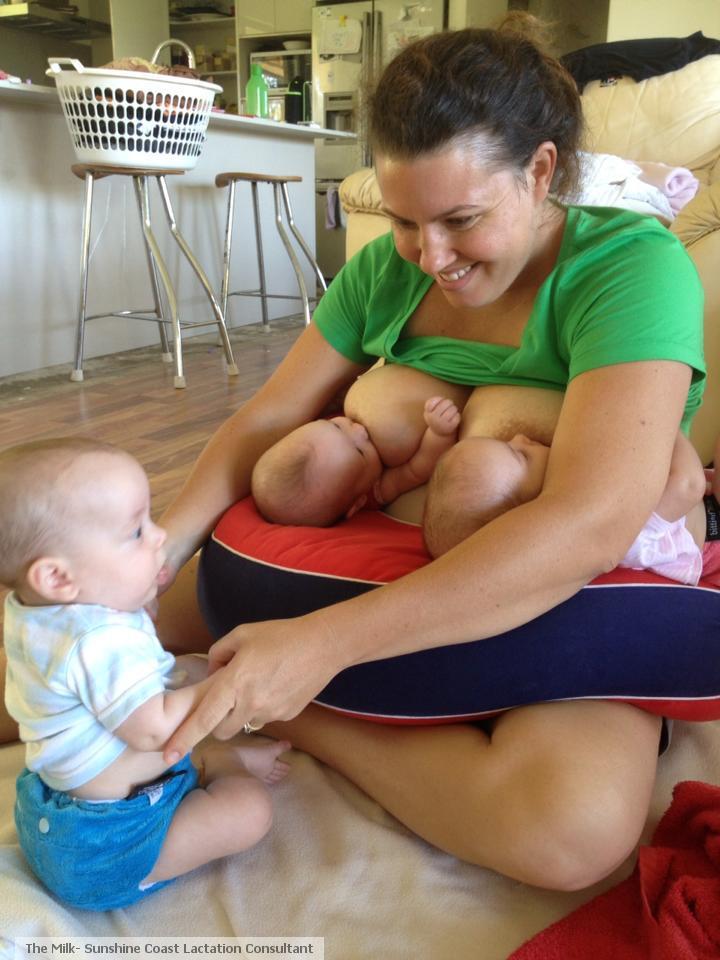 If the child sucks in the correct position, then the nipple is located at the level of the soft palate and does not participate in the actual sucking. The child sucks not the nipple, but the areola, massaging, decanting it with the tongue. A breast with a flat or inverted nipple is difficult for a baby to hold in his mouth while suckling and it is more difficult for him to suck on it. Mom should show patience and perseverance in the first days after the birth of a child. Any child is perfectly trained to suck even the most uncomfortable, from our point of view, breast.
If the child sucks in the correct position, then the nipple is located at the level of the soft palate and does not participate in the actual sucking. The child sucks not the nipple, but the areola, massaging, decanting it with the tongue. A breast with a flat or inverted nipple is difficult for a baby to hold in his mouth while suckling and it is more difficult for him to suck on it. Mom should show patience and perseverance in the first days after the birth of a child. Any child is perfectly trained to suck even the most uncomfortable, from our point of view, breast.
The nipple changes shape during sucking, stretches and takes on a more comfortable shape for the baby, usually in 3-4 weeks. There are also various devices called "nipple formers". They are put on immediately after feeding, when the nipple is slightly extended by the efforts of the child and worn until the next application. The nipple formers hold the nipple in an extended position. But even without these things it is quite possible to do.
It is very important for a mother with flat or inverted nipples to ensure that her baby never suckles anything but her mother's breast after birth. The child of such a mother, having sucked on a bottle or a pacifier, quickly realizes that this is a more convenient object for sucking and begins to refuse the breast. In this situation, mom will need even more patience and perseverance.
"You can't keep a newborn at the breast for more than 5 minutes, otherwise there will be cracks"
The child should be kept at the breast for as long as he needs. Feeding ends when the baby himself releases the breast.
If we talk about cracks, then there are only three groups of causes that lead to their formation
- Mom washes her breasts before each feeding. If she does this (and even with soap, and even anoints with brilliant green after feeding - a favorite pastime in Russian maternity hospitals, for example) - she constantly washes off the protective layer from the areola, which is produced by special glands located around the nipple, and dries the skin.
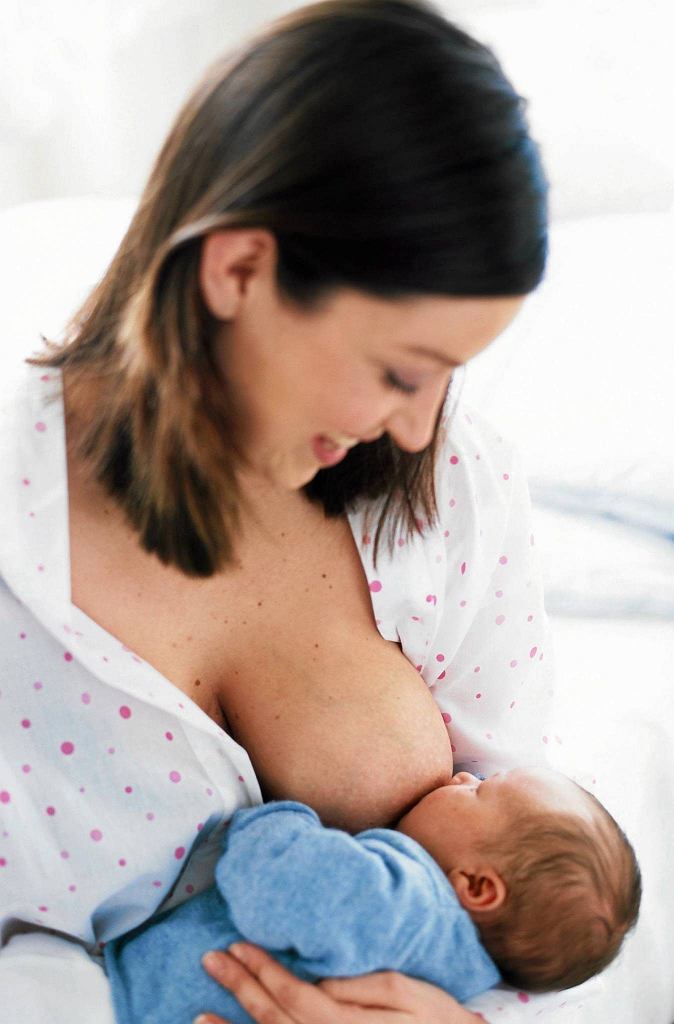 This protective lubricant exists just to prevent the loss of moisture in the delicate skin of the nipple, it has bactericidal properties and inhibits the growth of pathogenic microorganisms and, which is especially important for the child, smells about the same as amniotic fluid. The sensitive skin of some women cannot tolerate such exposure for a long time and begins to crack, even with proper attachment of the baby.
This protective lubricant exists just to prevent the loss of moisture in the delicate skin of the nipple, it has bactericidal properties and inhibits the growth of pathogenic microorganisms and, which is especially important for the child, smells about the same as amniotic fluid. The sensitive skin of some women cannot tolerate such exposure for a long time and begins to crack, even with proper attachment of the baby. -
Causes related to the incorrect position and behavior of the baby at the breast: the baby is not properly attached and sucks in the wrong position. And if this is true, then 5 minutes after 3 hours is enough for the formation of abrasions, and then cracks. The baby may latch on correctly, but in the process of suckling, he may perform various actions that can lead to cracking if the mother does not know that these actions need to be corrected and not allowed to behave like this. It must be remembered that the child has not suckled before, and does not know how to do it (he knows only the general principle of sucking).
 Unfortunately, most mothers also do not know how a baby should behave at the breast; they have never, or almost never seen it. What shouldn't a child be allowed to do? "Move out" to the tip of the nipple. This happens especially often if, during sucking, the child does not stick his nose into his mother's breast. If the mother feels that the grip is changing, she should try to press the baby with her nose to her chest. Very often this is enough for the child to “put on” correctly.
Unfortunately, most mothers also do not know how a baby should behave at the breast; they have never, or almost never seen it. What shouldn't a child be allowed to do? "Move out" to the tip of the nipple. This happens especially often if, during sucking, the child does not stick his nose into his mother's breast. If the mother feels that the grip is changing, she should try to press the baby with her nose to her chest. Very often this is enough for the child to “put on” correctly.
If this does not help, the nipple must be removed and re-inserted correctly. The baby should not suckle the breast incorrectly for a single minute. He doesn’t care how to suck, he doesn’t know that he hurts his mother, he doesn’t know that the wrong position does not allow him to suck out enough milk, he doesn’t know that with the wrong position there is not enough stimulation of his mother’s breast and there will not be enough milk production. You can not let the child play with the nipple. A child who has learned to slide down on the tip of the nipple sometimes begins to pass the nipple back and forth through the parted jaws. Mom, of course, it hurts or is unpleasant, but in most cases, mothers allow this to be done “If only he sucked ...” they say ... Why? It often happens that children who do not feel the touch of the breast with their nose during sucking, or do not feel it very well, begin to make search movements with the nipple in their mouth. Here you need to gently press the baby to your chest so that he understands that he is already in place and there is nothing more to look for. Sometimes, especially if the mother has long and large nipples, the baby grabs the breast in several steps, “climbing” up in several movements. This also happens in cases where the child has already sucked on the pacifier and does not open his mouth well. The nipple is injured so very quickly. To avoid this, it is necessary to properly insert the nipple into the wide-open mouth, bringing the nipple itself past the jaws, as deep as possible.
A child who has learned to slide down on the tip of the nipple sometimes begins to pass the nipple back and forth through the parted jaws. Mom, of course, it hurts or is unpleasant, but in most cases, mothers allow this to be done “If only he sucked ...” they say ... Why? It often happens that children who do not feel the touch of the breast with their nose during sucking, or do not feel it very well, begin to make search movements with the nipple in their mouth. Here you need to gently press the baby to your chest so that he understands that he is already in place and there is nothing more to look for. Sometimes, especially if the mother has long and large nipples, the baby grabs the breast in several steps, “climbing” up in several movements. This also happens in cases where the child has already sucked on the pacifier and does not open his mouth well. The nipple is injured so very quickly. To avoid this, it is necessary to properly insert the nipple into the wide-open mouth, bringing the nipple itself past the jaws, as deep as possible. Moms don't know how to breastfeed properly.
Moms don't know how to breastfeed properly.
A typical picture for maternity hospitals with separate stay is as follows: a baby was brought to the mother for 30 minutes, the baby held everything correctly and sucked well for these 30 minutes, he would still suck, but they came to pick him up and the mother pulls (slowly or quickly) his nipple from mouth. Six such pulls per day is enough for the development of abrasions. You can take the nipple only after opening the jaw with the little finger (quickly insert the tip of the finger into the corner of the mouth and turn it - it does not hurt at all and no one suffers).
Diseases of the skin of the nipples. Most often, mothers are faced with a fungal infection of the skin of the nipples - "thrush". In this situation, the skin most often looks "irritated", it can peel off, itch, cracks may appear, even despite proper application, there may be pain during and after sucking, piercing pains along the milk ducts. This problem is usually solved with the use of specific treatment and also has nothing to do with the topic of preparing the breast for feeding or the time the baby is at the breast.
“While there is no milk, it is necessary to drink more water”
The first day after childbirth, liquid colostrum forms in the breast of a woman, on the second day it becomes thick, on 3-4 days transitional milk may appear, 7-10-18 days - milk become mature. Colostrum is scarce and thicker than milk. This is the main argument in most Russian maternity hospitals in favor of supplementing and feeding the child (otherwise he allegedly suffers from hunger and thirst).
If a child needed large volumes of liquid immediately after birth, then nature would arrange the woman in such a way that she would be flooded with colostrum immediately after childbirth. But the child does not need extra water at all. All he needs he gets from colostrum and milk! The water that is given to the child while the mother has colostrum literally “washes away” the colostrum from the gastrointestinal tract, depriving the baby of the action of colostrum necessary for him. Water is given from a bottle, which leads to "tangled nipples" in the baby and may lead to refusal of the breast. Water causes a false feeling of fullness and reduces the need for suckling in a child. If we give a child 100 g of water per day, he sucks 100 g less milk (this applies not only to a newborn). The kidneys of a newborn are not ready for a large load of water and begin to work with overload. The list of arguments against can be continued, but these are enough.
Water causes a false feeling of fullness and reduces the need for suckling in a child. If we give a child 100 g of water per day, he sucks 100 g less milk (this applies not only to a newborn). The kidneys of a newborn are not ready for a large load of water and begin to work with overload. The list of arguments against can be continued, but these are enough.
“While there is no milk, it is necessary to supplement the child with formula, otherwise he will lose weight, starve”
The child is not designed to receive anything other than colostrum and milk. In the first days after birth, one colostrum is enough for him. Weight loss in the first day of life is a physiological norm. Newborns lose up to 6-8% of their birth weight in the first two days of their lives. Most children regain their weight or begin to put on weight by 5-7 days of life. Supplementary feeding with a mixture in the first days of a child's life is nothing more than a gross interference in the functioning of the baby's body. You can call this intervention a metabolic catastrophe. But in most Russian maternity hospitals, this is completely ignored!
You can call this intervention a metabolic catastrophe. But in most Russian maternity hospitals, this is completely ignored!
In addition, the introduction of supplementary feeding is carried out through a bottle, which very quickly leads to "tangled nipples" and the baby refuses the breast. Sometimes one or two bottle feedings are enough to stop a baby from breastfeeding! The mixture causes a feeling of fullness, lingers in the stomach for a long time, the child has a reduced need to suckle the breast, which leads to a decrease in breast stimulation and a decrease in milk production.
“I feed my baby on demand! He demands from me in 3.5 hours!”
Feeding on demand means putting the baby to the breast for every disturbance or search. The baby needs breastfeeding around every sleep, he falls asleep at the breast and when he wakes up, he is given the breast. A newborn child in the first week of his life can indeed be applied relatively rarely - 7-8 times a day, but in the second week of life, the intervals between applications are always reduced. During wakefulness, the child can ask for a breast up to 4 times per hour, i.e. every 15 minutes! Usually a child fed on demand is applied in the first month of life 12 or more times a day, usually 16-20 times. If a child in the first months of life is applied less than 12 times, then the mother either does not notice his modest requests, or ignores them (meaning a healthy, physiologically mature child).
During wakefulness, the child can ask for a breast up to 4 times per hour, i.e. every 15 minutes! Usually a child fed on demand is applied in the first month of life 12 or more times a day, usually 16-20 times. If a child in the first months of life is applied less than 12 times, then the mother either does not notice his modest requests, or ignores them (meaning a healthy, physiologically mature child).
In the overwhelming majority of cases, at the moment when the child begins to ask for a breast more often, the mother decides that the child is starving and introduces supplementary feeding. And the child asks for breasts not at all because he is hungry. He constantly needs a sense of confirmation of physical contact with his mother. During his life in his mother's belly, he is very used to the following: warm, crowded, I hear my heart beating, my lungs breathe, my intestines growl, I smell and taste amniotic fluid (filling the baby's nose and mouth), almost all the time I suck a fist (studies suck). Only in these conditions the baby feels comfortable and safe. After childbirth, he can get into such conditions only if his mother takes him in her arms, puts him on her breast, and then he will again feel cramped, warm, he will hear familiar rhythms, start sucking and feel the familiar smell and taste (the smell and taste of milk are similar to the taste and smell of amniotic fluid). And a newborn child wants to get into such conditions as often as possible. And a modern mother is waiting, she can’t wait, when the intervals between feedings will increase, when will the child start eating in 3.5-4 hours, when will he stop waking up at night ??? Hurry!!! And, usually, to the timid attempts of the child to ask for a breast, he answers with a pacifier, a rattle, gives some water, talks, entertains. The child is most often applied to the breast only when he wakes up. And he quickly agrees with this position. The child always takes the mother's position. But here a “pitfall” awaits mother and baby - insufficient breast stimulation and, as a result, a decrease in the amount of milk.
Only in these conditions the baby feels comfortable and safe. After childbirth, he can get into such conditions only if his mother takes him in her arms, puts him on her breast, and then he will again feel cramped, warm, he will hear familiar rhythms, start sucking and feel the familiar smell and taste (the smell and taste of milk are similar to the taste and smell of amniotic fluid). And a newborn child wants to get into such conditions as often as possible. And a modern mother is waiting, she can’t wait, when the intervals between feedings will increase, when will the child start eating in 3.5-4 hours, when will he stop waking up at night ??? Hurry!!! And, usually, to the timid attempts of the child to ask for a breast, he answers with a pacifier, a rattle, gives some water, talks, entertains. The child is most often applied to the breast only when he wakes up. And he quickly agrees with this position. The child always takes the mother's position. But here a “pitfall” awaits mother and baby - insufficient breast stimulation and, as a result, a decrease in the amount of milk.
“Feeding on demand is a nightmare! It is impossible to sit and feed the child for days!”
That's what mothers who can't breastfeed say. With properly organized feeding, mom is resting! She lies, relaxed, hugs the baby, the baby sucks. What could be better? Most women cannot find a comfortable position, they sit, they hold the child awkwardly, their back or arm numbs, if they feed lying down, it usually “hangs” over the child on the elbow, the elbow and back become numb. Moreover, if the child does not take the breast well, it hurts the mother ... What kind of pleasure can we talk about here? In the first month - one and a half after childbirth, when the child is applied chaotically, without a pronounced regimen, sucks often and for a long time, the mother can feel good only if breastfeeding is organized correctly, it is convenient for the mother to feed, she knows how to do it standing, lying down and sitting, and even moving.
“After each feeding, you must express the rest of the milk, otherwise the milk will be wasted”
No, you do not need to express after each feeding if breastfeeding is properly organized. If you feed your baby 6 times a day and do not express, indeed, milk can disappear very quickly. If you express after each feeding, then you can support lactation for some time. The terms are different, but rarely it is more than six months, cases of feeding on such behavior for more than a year are isolated.
If you feed your baby 6 times a day and do not express, indeed, milk can disappear very quickly. If you express after each feeding, then you can support lactation for some time. The terms are different, but rarely it is more than six months, cases of feeding on such behavior for more than a year are isolated.
When feeding a baby on demand, the mother always has as much milk as the baby needs and there is no need to pump after each application. In order for the newborn to completely suck out the breast, it is applied to one breast for 2-3 hours, and to the other for the next 2-3 hours. Somewhere after 3 months, when the child is already applied relatively rarely, he may need a second breast in one attachment, then the next time he is applied to the one that was last.
There is one unpleasant “pitfall” in regular pumping after feeding, which even most doctors are not aware of. It's called lactase deficiency. When a mother expresses after a feed, she expresses just the “hind” fatty milk, which is relatively poor in milk sugar, lactose. She feeds the child mainly with the anterior portion, which accumulates in the breast between rare feedings. There is a lot of lactose in the anterior portion. The child is fed "only lactose", the gastrointestinal tract of the child after some time ceases to cope with such volumes of lactose. Lactase deficiency develops (Lactase is an enzyme that breaks down lactose - milk sugar, it begins to be missed). This is one of the reasons for the development of lactase deficiency; the second, for example, is this: the mother gives the child two breasts in one feeding. But about this separately.
She feeds the child mainly with the anterior portion, which accumulates in the breast between rare feedings. There is a lot of lactose in the anterior portion. The child is fed "only lactose", the gastrointestinal tract of the child after some time ceases to cope with such volumes of lactose. Lactase deficiency develops (Lactase is an enzyme that breaks down lactose - milk sugar, it begins to be missed). This is one of the reasons for the development of lactase deficiency; the second, for example, is this: the mother gives the child two breasts in one feeding. But about this separately.
“You should give your baby two breasts at one feeding.”
No, it is not necessary to give two breasts. A newborn baby can be applied for 1.5-3 hours to one breast. Then 1.5-3 hours to another (for example, the baby woke up, sucked a little and didn’t want to anymore, but after 30 minutes he wanted to suck a little more. After 20 minutes, he sucked longer and fell asleep; all these attachments were from one breast; when the baby wakes up, you can offer him another breast). We need this so that the baby sucks the breast to the end, and receives "front" and "hind" milk in a balanced amount. If the baby is transferred to the other breast in the middle of feeding, he will receive less fat-rich hind milk. He will suck mainly the front portion from one breast and add the same from the other. Foremilk is rich in lactose, and after a while the baby can no longer cope with the load of lactose. Lactose intolerance develops.
We need this so that the baby sucks the breast to the end, and receives "front" and "hind" milk in a balanced amount. If the baby is transferred to the other breast in the middle of feeding, he will receive less fat-rich hind milk. He will suck mainly the front portion from one breast and add the same from the other. Foremilk is rich in lactose, and after a while the baby can no longer cope with the load of lactose. Lactose intolerance develops.
Transferring a baby from one breast to another can cause hyperlactation in some women, and if the mother also expresses both breasts after each feeding ... There are such mothers. Curtailing excess milk is sometimes more difficult than adding missing ... In some cases, feeding at one feeding from two breasts is necessary to stimulate lactation when there is a shortage of milk. A growing baby, most often after 3-4 months, may need two breasts in one feeding. Then the next application begins with the breast that was last.
“The more liquid you drink, the more milk”
There are mothers who try to drink as much as possible, sometimes up to 5 liters of liquid per day. And a nursing mother should drink only as much as she wants. By thirst. Mom shouldn't be thirsty. And if water is drunk on purpose, and even more than 3-3.5 liters per day, lactation can begin to be suppressed.
And a nursing mother should drink only as much as she wants. By thirst. Mom shouldn't be thirsty. And if water is drunk on purpose, and even more than 3-3.5 liters per day, lactation can begin to be suppressed.
“Sucking the fist is very harmful”
The whole end of pregnancy the child sucked the fist, so he learned to suck. Fist sucking is one of the inborn habits of a newborn. After childbirth, the baby begins to suck on the fist as soon as it enters his mouth. At 3-4 months, the fist is the first thing that the baby can put into his mouth on his own. He can do things on his own!!! This is amazing! And at this age, many babies begin to actively suck their fingers and fists. There is nothing wrong with that. Mom only needs to watch the baby a little. If a baby plays with a fist, then he sucks, then he stops, he can not be distracted from this activity. If the baby begins to actively suck the fist, then the baby wants to suck for real, offer him a breast. If the need to suckle the baby is fully satisfied by the breast, then the baby stops sucking the fist by 5-6 months. (Then, at 6-7 months, he begins to “look for teeth”, but this is a completely different behavior). The cam baby sucks almost the same as the breast, opening its mouth wide. Some babies have a very funny behavior when, having stuck to the chest, the baby tries to put his fist in his mouth ...
(Then, at 6-7 months, he begins to “look for teeth”, but this is a completely different behavior). The cam baby sucks almost the same as the breast, opening its mouth wide. Some babies have a very funny behavior when, having stuck to the chest, the baby tries to put his fist in his mouth ...
"My baby needs a pacifier"
The baby is not designed by nature to suckle anything other than the breast (and the fist, in a pinch). A child is always taught to use a pacifier. There are children who immediately push out the pacifier with their tongue. And there are those who begin to suck it. There are mothers who hold the pacifier with their finger so that her child does not push it out. Usually, the first time a baby gets a dummy is when he showed concern and the mother does not know how to calm him down. To calm down, the child needs to suck on the breast, well, they didn’t give him a breast, they gave him something else, he will have to suck what they give ...
“A child often asks for breasts, which means that he is hungry, there is not enough milk for him”
As mentioned above, a newborn child asks to be breastfed often, not at all because he is hungry. He wants to suck, he wants to mom. He constantly needs confirmation of psycho-emotional and physical contact with his mother.
He wants to suck, he wants to mom. He constantly needs confirmation of psycho-emotional and physical contact with his mother.
“Sufficient milk or not, we will find out on control feeding”
We will not learn anything on control feeding (the child is weighed before and after feeding, the difference is calculated and find out how much he sucked for feeding). Because:
- A baby who feeds on demand constantly sucks different portions of milk. In one application 5 ml, in another - 50, in the third - 150. You can get 5 ml. (I once weighed my daughter after 30 minutes of suckling. She gained 14 g. In the first month of her life, she gained 1200 g - and what would the district pediatrician tell me if this was control feeding in the clinic?)
- The newborn is designed to receive small portions of milk, but often. The vast majority of newborns in the conditions of feeding 6-7 times a day still suck out small portions of milk, and not 6 times 120 ml. And of course they don't eat.
 They start gaining poorly or stop gaining weight, or lose weight altogether.
They start gaining poorly or stop gaining weight, or lose weight altogether.
Whether or not enough milk is available can be determined in two ways:
Wet diaper test. (This is a test for wet diapers, not for used diapers, because you need to know exactly the number of urination). If a child older than 7 days pees more than 6-8 times a day, his urine is light, transparent, odorless, then he receives a sufficient amount of milk. Usually the child pees during wakefulness every 15-30 minutes. If a mother uses diapers, but wants to find out if there is enough milk or not, she needs to remove the diapers from the child for three hours. If the baby pees 3-4 times or more in three hours, then you can not count further. If you peed 3 times or less, we count for 6 hours. If in six hours he peed 4-5 times or more, you can not count further, if less than 4, we count further. And so on… Weekly weight gain (for a child older than 7 days) should be between 125 and 500 g.
“If applied frequently, the baby will suck everything out quickly, the breast is soft all the time – there is no milk. It is necessary to “save” milk for feeding”
It is necessary to “save” milk for feeding”
When feeding a child on demand, the breast becomes soft about a month after the start of feeding, when lactation becomes stable. Milk begins to be produced only when the baby suckles. The breast is never “empty”, in response to the sucking of the child, milk is constantly produced in it. If the mother is trying to fill her breasts for feeding, waiting for the breasts to “fill up”, she gradually reduces the amount of milk by such actions. The more mother attaches the child, the more milk, and not vice versa.
“The stomach needs to rest”
But the child's stomach doesn't work very well. Milk there only curdles and is quickly evacuated to the intestines, where the actual digestion and absorption takes place. This is the prejudice from the old song about feeding according to the schedule after 3 hours. The newborn does not have a clock. No mammal makes even intervals in feeding its newborns. The body of the child is adapted to the continuous flow of mother's milk, and he does not need to rest at all.
“After each feeding, keep the baby upright for 20 minutes”
Do not hold the baby upright after each feeding, especially if the baby has fallen asleep. Most of the time the baby lies on its side. If he burps a little, then the diaper just changes under his cheek. It is necessary to hold the artificial man vertically so that he does not spill the 120g poured into him. And we are talking about babies who are fed on demand and receive small portions of mother's milk. In addition, the cardiac sphincter of the stomach needs training, which it can only receive if the child is lying down.
“You need to sleep at night”
At night, you need to not only sleep, but suck your breast. Most newborn children are so arranged that they sleep from 10-11 pm to 3-4 am, then they begin to wake up and ask for breasts. In a child of the first month of life, applications in the morning hours (from 3 to 8) are usually 4-6. Night feedings with properly organized breastfeeding look something like this: the baby got worried, the mother put it to the breast, the baby sleeps sucking and the mother also sleeps, after a while he lets go of the breast and sleeps more soundly. And such episodes happen in a night 4-6. All this is easy to organize if the mother sleeps with her child, and for this she needs to be able to feed lying down in a comfortable position.
And such episodes happen in a night 4-6. All this is easy to organize if the mother sleeps with her child, and for this she needs to be able to feed lying down in a comfortable position.
If the baby sleeps separately from the mother, in his own bed, then he stops waking up for morning feedings, sometimes already a week after birth, sometimes by 1.5-2 months. Most modern mothers take this with relief, because. for them, finally, the night running back and forth, nodding while sitting in a chair or on a bed over a sucking child, and some also pumped at night ... And here they are waiting for a pitfall called insufficient stimulation of prolactin and, as a result, a decrease in the amount of milk . A mother and her child are a wonderful self-regulating system. While the baby has a need to suck in the morning, his mother produces the maximum amount of prolactin, just from about 3 to 8 in the morning.
Prolactin is always present in the female body in small amounts, its concentration in the blood increases significantly after the baby begins to breastfeed, most of all it is obtained in the morning hours from 3 to 8 in the morning.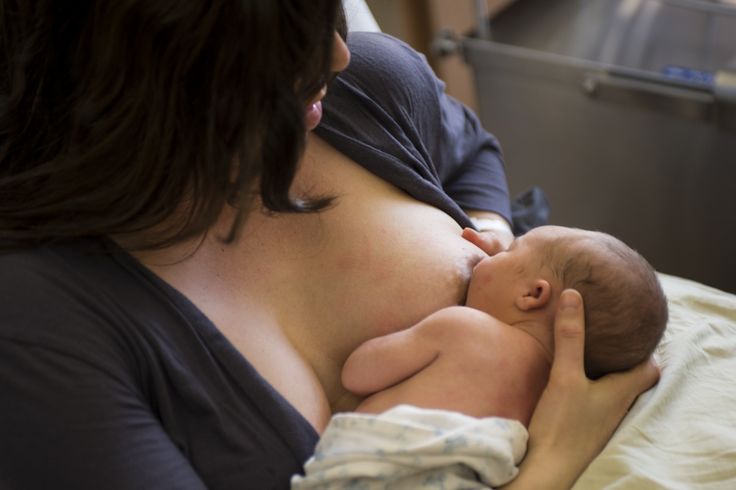 Prolactin, which appeared in the morning, is engaged in the production of milk during the day. It turns out who sucks at night, stimulates his mother's prolactin and provides himself with a decent amount of milk during the day. And whoever fails to suckle at night, he can quite quickly be left without milk during the day. No mammal takes a nightly break from feeding its young.
Prolactin, which appeared in the morning, is engaged in the production of milk during the day. It turns out who sucks at night, stimulates his mother's prolactin and provides himself with a decent amount of milk during the day. And whoever fails to suckle at night, he can quite quickly be left without milk during the day. No mammal takes a nightly break from feeding its young.
“I lost my milk because of my “nerves””
Milk production depends on the hormone prolactin, the amount of which depends on the number of times the baby is latched on and nothing else. The experiences of the mother on any occasion do not affect him. But the release of milk from the breast depends on the hormone oxytocin, which is engaged in the fact that it contributes to the contraction of muscle cells around the lobules of the gland and thereby contributes to the flow of milk. The amount of this hormone is very dependent on the psychological state of the woman. If she is frightened, tired, in pain or in any other discomfort during feeding, oxytocin stops working and milk stops flowing from the breast. A child cannot suck it out, a breast pump does not express it, and it cannot come out with its hands ...
A child cannot suck it out, a breast pump does not express it, and it cannot come out with its hands ...
The manifestation of the “oxytocin reflex” was observed by every breastfeeding woman: when a mother hears the crying of a child (and not necessarily her own), her milk begins to leak. The body tells the mother that it is time to apply the baby. In a situation of stress or fear, nothing like this is observed. (Relationship to the ancient instinct of self-preservation: if a woman runs from a tiger and she smells of leaking milk, the tiger will find and eat her faster, so while she runs in fear through the jungle with a child under her arm, the milk will not leak when she gets to the safety of the cave - and calmly settle down to feed the child, the milk will come again.)
Modern stressful situations work like those tigers. In order for milk to flow out again, you must try to relax during feeding, think only about the child. You can drink soothing herbs, shoulder massage, calm conversation helps well. Anything to help you relax. And most modern mothers are not able to relax during feeding, it is uncomfortable for them to sit or lie down, it can be painful to feed - all this prevents the manifestation of the oxytocin reflex - milk remains in the breast, which leads to a decrease in lactation.
Anything to help you relax. And most modern mothers are not able to relax during feeding, it is uncomfortable for them to sit or lie down, it can be painful to feed - all this prevents the manifestation of the oxytocin reflex - milk remains in the breast, which leads to a decrease in lactation.
"The baby is too fat, it is necessary to limit the number of feedings and give water"
A breastfed child gains 125 to 500 g per week, or 500 to 2000 g per month. Usually, by 6 months, a child born with a weight of 3-3.5 kg weighs about 8 kg. The rate of gain is very individual, there is never any talk of "overfeeding", children who are actively gaining weight grow rapidly in length and look proportionate. Children who gain 1.5-2 kg per month in the first half of life, usually sharply reduce weight gain in the second half of the year and can weigh 12-14 kg by the year. There is never a need to limit the number of feedings, much less to give water.
“Baby lacks nutrients, needs complementary foods from the age of 4 months”
The need for other food manifests itself in a child of about 6 months of age, when he begins to actively wonder what everyone is eating there. And if a mother takes a baby to the table with her, he begins to actively take an interest in the contents of his plate. This behavior is called active food interest, and it indicates that the child is ready to get acquainted with new food and can begin it. Nevertheless, breast milk remains the main food of the child in the first year of life, and in many cases even at the beginning of the second, contains absolutely all the nutrients the child needs and much more.
And if a mother takes a baby to the table with her, he begins to actively take an interest in the contents of his plate. This behavior is called active food interest, and it indicates that the child is ready to get acquainted with new food and can begin it. Nevertheless, breast milk remains the main food of the child in the first year of life, and in many cases even at the beginning of the second, contains absolutely all the nutrients the child needs and much more.
"A nursing mother should have a strict diet"
Food should be habitual. It is preferable not to use exotic foods in the diet that are not characteristic of the "native" climatic zone. A breastfeeding mother may have interesting nutritional needs, and they must be met in the same way as the desires of a pregnant woman. A woman should eat according to her appetite, and not stick food for two into herself. And, of course, you need to try to eat healthy food. Do not use products containing preservatives, dyes and other unhealthy substances.








